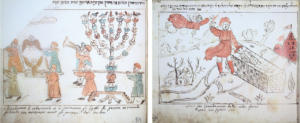Jews, politics, and Italian Renaissance: a major international project to shed light
 The relation between Jews and politics is generally addressed from the era of Emancipation onwards. Everything that precedes this historical phase, decisive in its importance, is generally neglected and very little explored in its many and complex folds. A major international project initiated by the École française of Rome with the collaboration of the Sapienza University and other universities, both Italian and foreign, aims to fill this gap. “Jews in Politics in Long Renaissance Italy”, presented last week, has the broad scope of five years of work that will result in a series of conferences, studies, publications.
The relation between Jews and politics is generally addressed from the era of Emancipation onwards. Everything that precedes this historical phase, decisive in its importance, is generally neglected and very little explored in its many and complex folds. A major international project initiated by the École française of Rome with the collaboration of the Sapienza University and other universities, both Italian and foreign, aims to fill this gap. “Jews in Politics in Long Renaissance Italy”, presented last week, has the broad scope of five years of work that will result in a series of conferences, studies, publications.
The next appointment is scheduled on 12 and 13 September, in Rome, in the premises of the largest university in Europe, where many topics will be discussed, among which “Jews in politics in the Italian Renaissance” (Giuseppe Veltri and Serena Di Nepi), “Italian responsa as a source for the study of the political power of rabbis in the 16th and 17th centuries “(Asher Salah), and “Political language of the Jews and Christian representation of politics “(Giacomo Todeschini). These are just some of the many perspectives that will allow a reality livelier and more influential than one is led to imagine to emerge within the majority society.
“This is a new historiographical proposal for a project “, explained Pierre Savy, director of mediaeval studies at the École Française of Rome and author of the volume World History of the Jews, recently published in Italy by Laterza in a version revised and adapted under the supervision of historian Anna Foa. Along with École française, five different institutions participate: the University of Hamburg with Professor Giuseppe Veltri, the University of Pisa with Professor Alessandra Veronese, and the University of Calabria with Professor Guido Bartolucci. A large group of leading scholars will be involved from Italy and European countries, the United States and Israel.
“The main research question revolves about the Jewish political agency in Renaissance Italy”, points out Pierre Savy. At a chronological level, the project will investigate the period between 13th century and 17th century in the Italian peninsula. It will inquire in parallel (and maybe in comparison) on different periods and states so as to trace relationships across times and spaces and between States where Jews were allowed to live and States where they were not allowed to stay after the series of Spanish expulsions.
“The minority condition and the uninterrupted negotiations with local government set specific political participation processes could be detectable in important sources”, he remarks. “But this participation and this documentation has so far been neglected by historiography. We intend to study this ‘Jewish politics’ to demonstrate the existence of a political agency and to describe it, in its particularities (pragmatism, pursuit of group interests, recourse to intercession and alliance, its own institutional and documentary structuring) and in its interactions with European policy”.
“The project – he concludes – raises essential methodological questions and for this reason we believe that possible answers can come only by intertwining different research approaches. For this reason, we have involved scholars from different disciplines in our team and we aim to develop a specific working methodology”.
Above, a rare Renaissance manuscript known as the “Bible of Moses of Castellazzo” acquired by MEIS – Museum of Italian Judaism and the Shoah in Ferrara known as the “Bible of Moses from Castellazzo”.
